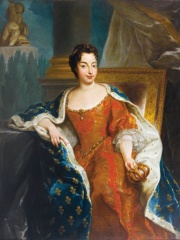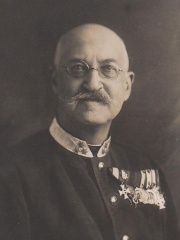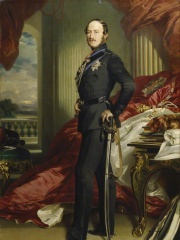
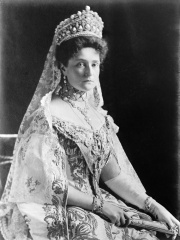
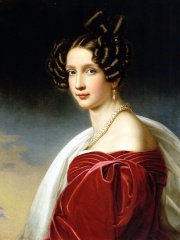
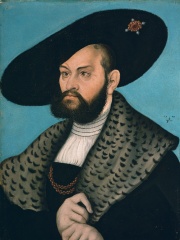
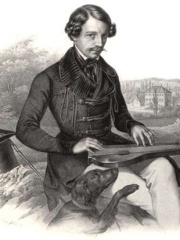

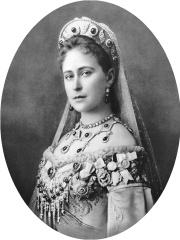
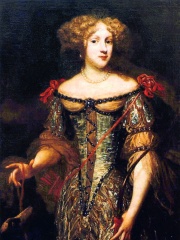
The Most Famous
NOBLEMEN from Germany
Top 10
The following people are considered by Pantheon to be the top 10 most legendary German Noblemen of all time. This list of famous German Noblemen is sorted by HPI (Historical Popularity Index), a metric that aggregates information on a biography's online popularity. Visit the rankings page to view the entire list of German Noblemen.

1. Albert, Prince Consort (1819 - 1861)
With an HPI of 84.15, Albert, Prince Consort is the most famous German Nobleman. His biography has been translated into 62 different languages on wikipedia.
Prince Albert of Saxe-Coburg and Gotha (Franz August Karl Albert Emanuel; 26 August 1819 – 14 December 1861) was the husband of Queen Victoria. As such, he was consort of the British monarch from their marriage on 10 February 1840 until his death in 1861. Victoria granted him the title Prince Consort in 1857. Albert was born in the Saxon duchy of Saxe-Coburg-Saalfeld to a family connected to many of Europe's ruling monarchs. At the age of 20, he married Victoria, his first cousin, with whom he had nine children. Initially, he felt constrained by his role as consort, which did not afford him power or responsibilities. He gradually developed a reputation for supporting public causes, such as educational reform and the abolition of slavery worldwide, and he was entrusted with running the Queen's household, office and estates. He was heavily involved with the organisation of the Great Exhibition of 1851, which was a resounding success. Victoria came to depend more and more on Albert's support and guidance. He aided the development of Britain's constitutional monarchy by persuading his wife to be less partisan in her dealings with the British parliament, but he actively disagreed with the interventionist foreign policy pursued during Henry John Temple, 3rd Viscount Palmerston's tenure as Foreign Secretary. Albert died in 1861 at the age of 42, devastating Victoria so much that she entered into a deep state of mourning and wore black for the rest of her life. On the day of her death in 1901, their eldest son succeeded as Edward VII, the first British monarch of the House of Saxe-Coburg and Gotha, named after the ducal house to which Albert belonged.

2. Alexandra Feodorovna (1872 - 1918)
With an HPI of 81.49, Alexandra Feodorovna is the 2nd most famous German Nobleman. Her biography has been translated into 58 different languages.
Alexandra Feodorovna (Russian: Александра Фёдоровна Романова, romanized: Aleksandra Fyodorovna Romanova; born Princess Alix of Hesse and by Rhine; 6 June 1872 – 17 July 1918) was the last empress of Russia as the consort of Nicholas II from their marriage on 26 November [O.S. 14 November] 1894 until his forced abdication on 15 March [O.S. 2 March] 1917. A granddaughter of Queen Victoria, Alexandra was one of the most famous royal carriers of hemophilia and passed the condition to her son, Alexei Nikolaevich, Tsarevich of Russia. Alexandra was deeply involved in the personal and political life of her husband, Tsar Nicholas II. Her reputation suffered due to her influence over Nicholas, particularly in her insistence on maintaining autocratic rule in the face of growing revolutionary pressures in Russia. Her relationship with the Russian mystic Grigori Rasputin became a subject of controversy. Rasputin's alleged ability to alleviate Alexei's suffering from hemophilia increased Alexandra's reliance on him, damaging the public perception of the Romanovs and fueling rumors about Rasputin's power within the royal family. These associations with Rasputin and her opposition to political reform were seen as contributing factors to the collapse of the Romanov dynasty. Following Nicholas II's abdication, the imperial family were placed under house arrest by the Bolsheviks during the Russian Revolution. On 17 July 1918, they were murdered by Bolshevik forces in Yekaterinburg, marking the violent end of over three centuries of Romanov rule. Despite her unpopularity during her reign, Alexandra was canonized as Saint Alexandra the Passion Bearer by the Russian Orthodox Church in 2000.

3. Princess Sophie of Bavaria (1805 - 1872)
With an HPI of 79.63, Princess Sophie of Bavaria is the 3rd most famous German Nobleman. Her biography has been translated into 32 different languages.
Princess Sophie of Bavaria (Sophie Friederike Dorothea Wilhelmine; German: [zoˈfiː ˌfʁiːdəˈʁiːkə doʁoˈteːa vɪlhɛlˈmiːnə]; 27 January 1805 – 28 May 1872) was the daughter of King Maximilian I Joseph of Bavaria and his second wife, Caroline of Baden. The identical twin sister of Queen Maria Anna of Saxony, Sophie became Archduchess of Austria by marriage to Archduke Franz Karl of Austria. Her eldest son, Franz Joseph, reigned as Emperor of Austria and King of Hungary; her second son, Maximilian, briefly reigned as Emperor of Mexico.

4. Albert, Duke of Prussia (1490 - 1568)
With an HPI of 75.16, Albert, Duke of Prussia is the 4th most famous German Nobleman. His biography has been translated into 42 different languages.
Albert of Prussia (German: Albrecht von Preussen; 17 May 1490 – 20 March 1568) was a German prince who was the 37th grand master of the Teutonic Knights and, after converting to Lutheranism, became the first ruler of the Duchy of Prussia, the secularized state that emerged from the former Monastic State of the Teutonic Knights. Albert was the first European ruler to establish Lutheranism, and thus Protestantism, as the official state religion of his lands. He proved instrumental in the political spread of Protestantism in its early stage, ruling the Prussian lands for nearly six decades (1510–1568). Albert was great-grandson of the converted pagan ruler Jogaila of Poland and Lithuania, vanquisher of the Teutonic Knights at the Battle of Grunwald. He was also a member of the Brandenburg-Ansbach branch of the House of Hohenzollern. He became grand master of the Teutonic Knights in their attempt to diplomatically win over the Polish-Lithuanian union. His skill in political administration and leadership ultimately succeeded in reversing the decline of the Teutonic Order. But Albert was sympathetic to the demands of Martin Luther, whose teachings had become popular in his lands. So he rebelled against the Roman Catholic Church and the Holy Roman Empire by converting the Teutonic state into a Protestant and hereditary realm, the Duchy of Prussia, for which he paid homage to his uncle, Sigismund I, king of Poland. That arrangement was confirmed by the Treaty of Kraków in 1525. Albert pledged a personal oath to the king and in return was invested with the duchy for himself and his heirs. Albert's rule in Prussia was fairly prosperous. Although he had some trouble with the peasantry, the confiscation of the lands and treasures of the Catholic Church enabled him to propitiate the nobles and provide for the expenses of the newly established Prussian court. He was active in imperial politics, joining the League of Torgau in 1526, and acted in unison with the Protestants in plotting to overthrow Emperor Charles V after the issue of the Augsburg Interim in May 1548. Albert established schools in every town and founded the University of Königsberg in 1544. He promoted culture and arts, patronising the works of Erasmus Reinhold and Caspar Hennenberger. During the final years of his rule, Albert was forced to raise taxes instead of further confiscating now-depleted church lands, causing peasant rebellion. The intrigues of the court favourites Johann Funck and Paul Skalić also led to various religious and political disputes. Albert spent his final years virtually deprived of power, and died at Tapiau on 20 March 1568. His son, Albert Frederick, succeeded him as Duke of Prussia.
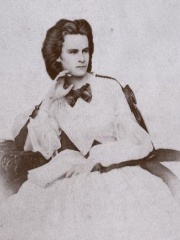
5. Duchess Helene in Bavaria (1834 - 1890)
With an HPI of 74.97, Duchess Helene in Bavaria is the 5th most famous German Nobleman. Her biography has been translated into 22 different languages.
Duchess Helene in Bavaria (Helene Caroline Therese; 4 April 1834 – 16 May 1890), nicknamed Néné, was the Hereditary Princess of Thurn and Taxis as the wife of Maximilian Anton Lamoral. She was a Duchess in Bavaria by birth as the daughter of Duke Maximilian Joseph and Princess Ludovika. She was temporarily the head of the Thurn and Taxis family. In 1858, Helene married Maximilian Anton, Hereditary Prince of Thurn and Taxis. After nearly nine years of marriage, Maximillian died due to a chronic kidney disease, leaving the Thurn and Taxis throne in the hands of Helene until their son reached maturity.

6. Duke Maximilian Joseph in Bavaria (1808 - 1888)
With an HPI of 74.89, Duke Maximilian Joseph in Bavaria is the 6th most famous German Nobleman. His biography has been translated into 26 different languages.
Duke Maximilian Joseph in Bavaria (4 December 1808 – 15 November 1888), known informally as Max in Bayern, was a member of a junior branch of the royal House of Wittelsbach who were Kings of Bavaria, and a promoter of Bavarian folk-music. He is most famous today as the father of Empress Elisabeth of Austria ("Sisi") and great-grandfather of King Leopold III of Belgium.

7. Prince Claus of the Netherlands (1926 - 2002)
With an HPI of 74.41, Prince Claus of the Netherlands is the 7th most famous German Nobleman. His biography has been translated into 39 different languages.
Prince Claus of the Netherlands, Jonkheer van Amsberg (born Klaus-Georg Wilhelm Otto Friedrich Gerd von Amsberg; 6 September 1926 – 6 October 2002) was Prince of the Netherlands from 30 April 1980 until his death on 6 October 2002, as the husband of Queen Beatrix. Initially a diplomat in the service of West Germany and West German deputy ambassador to Ivory Coast, Claus met Beatrix on New Year's Eve 1963 and married her in 1966. When his wife ascended to the throne in 1980, Claus took his place as Prince of the Netherlands, which he held until his death in 2002.

8. Princess Elisabeth of Hesse and by Rhine (1864 - 1918)
With an HPI of 73.65, Princess Elisabeth of Hesse and by Rhine is the 8th most famous German Nobleman. Her biography has been translated into 41 different languages.
Princess Elisabeth of Hesse and by Rhine (1 November 1864 – 18 July 1918), later known as Grand Duchess Elizabeth Feodorovna of Russia, was a German princess of the House of Hesse-Darmstadt, and the wife of Grand Duke Sergei Alexandrovich of Russia, the fifth son of Emperor Alexander II of Russia and Princess Marie of Hesse and by Rhine. A granddaughter of Queen Victoria and an older sister of Alexandra, the last Russian empress, Elisabeth became famous in Russian society for her dignified beauty and charitable works for the poor. Elisabeth married Grand Duke Sergei on 15 (3) June 1884. The couple never had children of their own, but their Ilyinskoye estate was usually filled with parties that Elisabeth organized especially for children. They eventually became the foster parents of Grand Duke Dmitry Pavlovich and Grand Duchess Maria Pavlovna, Sergei's niece and nephew. After the Socialist Revolutionary Party's Combat Organization assassinated her husband with a bomb in 1905, Elisabeth publicly forgave Sergei's murderer, Ivan Kalyayev, and unsuccessfully campaigned for him to be pardoned. She then left the royal society and became a nun. She opened the Marfo-Mariinsky Convent and spent time helping the poor of Moscow. During the February Revolution of 1917, which ended the Tsar's rule in Russia, Elisabeth's brother-in-law, Czar Nicholas II, was forced to abdicate the throne. The political upheavals initially had no impact on life in the monastery. However, Elisabeth was worried about her relatives, who were under house arrest in the Alexander Palace in Tsarskoye Selo. She kept in touch with her sister Alexandra, even when she was in exile in Tobolsk, although under considerably more difficult conditions. In 1918, she was arrested and ultimately murdered by Bolsheviks. Elisabeth was canonized by the Russian Orthodox Church Outside Russia in 1981 and in 1992 by the Moscow Patriarchate.

9. Elizabeth Charlotte, Madame Palatine (1652 - 1722)
With an HPI of 73.50, Elizabeth Charlotte, Madame Palatine is the 9th most famous German Nobleman. Her biography has been translated into 36 different languages.
Madame Elizabeth Charlotte, Duchess of Orléans (born Princess Elizabeth Charlotte of the Palatinate, German: Elisabeth Charlotte; 27 May 1652 – 8 December 1722), also known as Liselotte von der Pfalz, was a German member of the House of Wittelsbach who married into the French royal family. She was the second wife of Monsieur Philippe I, Duke of Orléans (younger brother of Louis XIV). By Philippe, Liselotte was the mother of Philippe II, Duke of Orléans, and Élisabeth Charlotte, Duchess of Lorraine. Philippe II was France's ruler during the Regency. Liselotte gained literary and historical importance primarily through preservation of her correspondence, which is of great cultural and historical value due to her sometimes very blunt descriptions of French court life and is today one of the best-known German-language texts of the Baroque period. Liselotte not only became the ancestress of the House of Orléans, which came to the French throne with Louis Philippe I, the so-called "Citizen King" from 1830 to 1848, but also became the ancestress of numerous European royal families, so she was also called the "Grandmother of Europe". Through her daughter she was the grandmother of Francis I, Holy Roman Emperor, the husband of Maria Theresa, and great-grandmother of Joseph II and Leopold II (both Holy Roman Emperors) and Marie Antoinette, the last Queen of France before the French Revolution.
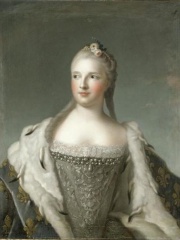
10. Maria Josepha of Saxony, Dauphine of France (1731 - 1767)
With an HPI of 73.36, Maria Josepha of Saxony, Dauphine of France is the 10th most famous German Nobleman. Her biography has been translated into 35 different languages.
Maria Josepha of Saxony (Maria Josepha Karolina Eleonore Franziska Xaveria; 4 November 1731 - 13 March 1767) was Dauphine of France through her marriage to Louis, the son and heir of Louis XV. Marie Josèphe was the mother of three kings of France, Louis XVI, Louis XVIII and Charles X, as well as the Queen of Sardinia and Madame Élisabeth.
People
Pantheon has 290 people classified as German noblemen born between 900 and 1985. Of these 290, 6 (2.07%) of them are still alive today. The most famous living German noblemen include Prince Ernst August of Hanover, Prince Max, Duke in Bavaria, and Gustav, 7th Prince of Sayn-Wittgenstein-Berleburg. The most famous deceased German noblemen include Albert, Prince Consort, Alexandra Feodorovna, and Princess Sophie of Bavaria. As of April 2024, 2 new German noblemen have been added to Pantheon including Gustav, 7th Prince of Sayn-Wittgenstein-Berleburg, and Prince Ernst August of Hanover.
Living German Noblemen
Go to all RankingsPrince Ernst August of Hanover
1954 - Present
HPI: 65.58
Prince Max, Duke in Bavaria
1937 - Present
HPI: 62.03
Gustav, 7th Prince of Sayn-Wittgenstein-Berleburg
1969 - Present
HPI: 50.07
Princess Claire of Luxembourg
1985 - Present
HPI: 48.31
Albert, 12th Prince of Thurn and Taxis
1983 - Present
HPI: 46.43
Prince Ernst August of Hanover
1983 - Present
HPI: 43.49
Deceased German Noblemen
Go to all RankingsAlbert, Prince Consort
1819 - 1861
HPI: 84.15
Alexandra Feodorovna
1872 - 1918
HPI: 81.49
Princess Sophie of Bavaria
1805 - 1872
HPI: 79.63
Albert, Duke of Prussia
1490 - 1568
HPI: 75.16
Duchess Helene in Bavaria
1834 - 1890
HPI: 74.97
Duke Maximilian Joseph in Bavaria
1808 - 1888
HPI: 74.89
Prince Claus of the Netherlands
1926 - 2002
HPI: 74.41
Princess Elisabeth of Hesse and by Rhine
1864 - 1918
HPI: 73.65
Elizabeth Charlotte, Madame Palatine
1652 - 1722
HPI: 73.50
Maria Josepha of Saxony, Dauphine of France
1731 - 1767
HPI: 73.36
Maria Anna Victoria of Bavaria
1660 - 1690
HPI: 72.87
Ernest Augustus, Crown Prince of Hanover
1845 - 1923
HPI: 72.83
Newly Added German Noblemen (2025)
Go to all RankingsGustav, 7th Prince of Sayn-Wittgenstein-Berleburg
1969 - Present
HPI: 50.07
Prince Ernst August of Hanover
1983 - Present
HPI: 43.49
Overlapping Lives
Which Noblemen were alive at the same time? This visualization shows the lifespans of the 25 most globally memorable Noblemen since 1700.







